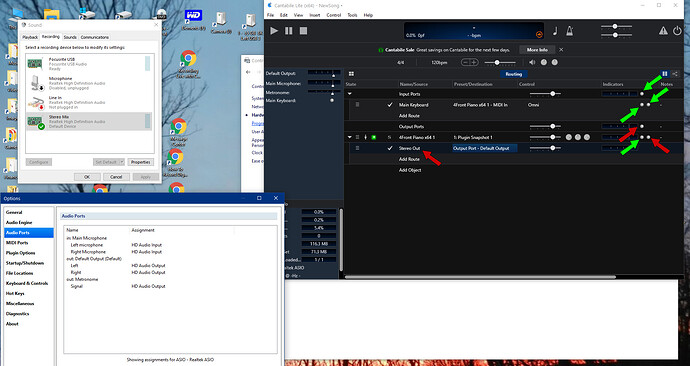I am totally new at this, have fiddled with Audacity to make a few voice audio recordings, and have used it to record singing along with a piano music track being played.
Here’s what I want to do, and would like to know if I am thinking about it in the correct way.
I want to use an instrument like an aerophone that has a midi-usb output to record one or more accompaniment tracks in audacity that have a piano sound. The aerophone does not itself have “piano” as an available sound. The reason I want to try this is that I can’t play the piano, but I can (ok, used to) play a sax, so I figured I could make some piano-sounding tracks that way.
Reading up a bit, I see that Audacity will not take MIDI as an input, so it seemed to me I would need to run something like Cantabile with a piano plugin, use an Aerophone as a midi input to the plugin ( like 4frontpiano) and run the output from the plugin into Audacity.
The problem I am running into: How do I get the output of the Cantabile plugin to be an input to Audacity? I can’t seem to figure out how to make Audacity see the output of the plugin as an input to record from.
And on the cantabile end of things, I cannot figure out how to output to Audacity.
Is my approach ok? Any suggestions appreciated. Thanks
Use a full DAW instead of trying to combine Cantabile and Audacity. In a DAW you can use VST instruments controlled by MIDI and record MIDI as well as audio tracks.
Google “free DAW” or try Reaper 
Thank you for the suggestion, I will go there if forced to, but first would really try to make this work, because both Cantabile and Audacity are fairly simple. I am showing a screen capture that I think indicates the problem is in outputting from Cantabile. Right now I am using a midi keyboard for my midi setup and that part seems to work.
If I am successful at uploading the screenshot (below), you can see in Cantabile, when I press a key on the keyboard, all the lights indicated by the green arrows light up, but the red arrows show nothing happening. So it looks to me as the input is all set up but the output is not. The screenshot also shows my sound setup.
Hey Clark
nobody is trying to force you ;-), but even though I love Cantabile to death, all my production work is done in Cubase and Reaper. It’s just the question of the right tools for the job: Cantabile is a super-powerful “container” to use plugins live, while a DAW is a production tool to combine audio and MIDI tracks, virtual instruments and plugins in order to produce songs.
Audacity is not a full DAW, more an audio editor - I see a number of people starting out with Audacity, because it’s simple and free, but as soon as they get to “real” production tasks, Audacity is too limited - they all switch to a “real” DAW sooner or later, which means re-learning a lot of skills.
So IMO, it’s better to start producing with a real DAW, because it will be able to keep up with you as your skills grow and the complexity of production tasks grows with them (insert and send effects, group tracks, buses, automation, sidechains, …).
If you really want to stick with connecting Cantabile and Audacity, take a look at Vincent Burel’s virtual audio cable - it allows you to take the output from one application (Cantabile) and connect it to the input of another application (Audacity). This way, you can record Cantabile’s output in Audacity.
Cheers,
Torsten
2 Likes
Torsten, thank you so much for taking the time to provide a good response. Since I have a very limited goal for myself in all this, I’m going to try “simple” first, which means I will definitely try the virtual audio cable. I realize it may not turn out to be “simple”, in which case I will follow your good advice and investigate a real DAW.
I do have Ableton lite that came with (as I recall) a Roland MIDI-to-USB cable, and OMG the learning curve for that – I’ll go there if I have to, but only after simple fails!
Thank you.
@ClarkNK think I was where you are several years ago. I’m a sax player and not a very good keyboard player (class piano like all music majors). I tried a number of EWI (Electronic Wind Instrument) MIDI saxes, but they are no substitute for a piano when making backing tracks.
To create backing tracks, I use Band-in-a-Box. BinB is a specialized DAW. It generates amazing tracks from just entering chords and information about the song. From there, you can substitute live parts, edit, arrange, combine, etc. It is not cheap and there is a learning curve, but it is amazing. It’s come a long way in the last few years from cheezy MIDI parts created by the developer to parts played by named studio musicians.
If you really want to get into creating your own tracks, take a look. Even if you play every instrument, it gives you a scratchpad to start song development.
2 Likes

